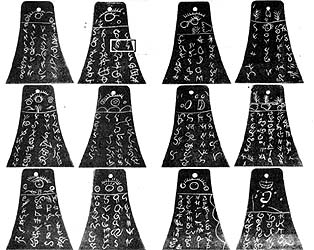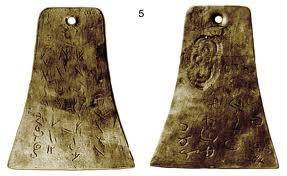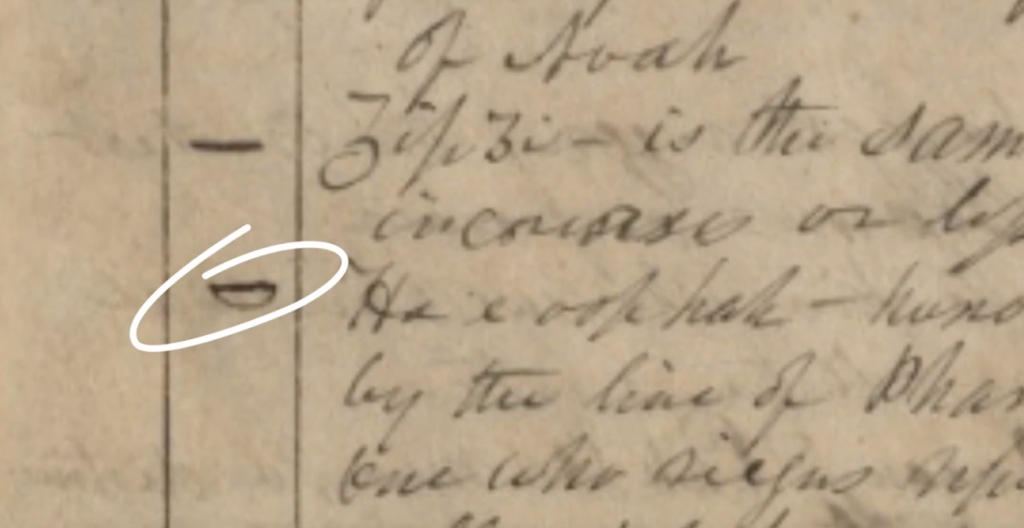Hello and welcome to another episode of Faith and Beliefs. Today we present to you: Chapter 40: The mysterious case of Joseph Smith and the Kinderhook Plates.
The year is 1843. About 75 miles south of Nauvoo, Illinois, a few people, including a couple of Latter-day Saints, are digging around and they discover these.


There were six copper plates with characters etched on the front and back. The black images you’re seeing are just copies of the copper originals.
Anyway, someone ends up taking these plates to Joseph Smith. In the journal of William Clayton, who was Joseph’s private clerk, we get the following, “Prest. J. has translated a portion and says they contain the history of the person with whom they were found and he was a descendant of ham through the loins of Pharaoh king of Egypt, and that he received his kingdom from the ruler of heaven and earth.” Clayton includes this information in History of the Church, but he writes in first person as if Joseph himself said it, which was pretty common for biographical works back then. But the source is obviously Clayton’s journal.
This is the only actual source we have indicating what Joseph’s purported partial translation consisted of. There was never a translation transcript or publication anywhere, unlike his other translations. Here comes the problem: 1879 rolls around. Brigham Young’s step-son, James T. Cobb (who was alienated from the Church), gets a letter from a guy named Wilbur Fugate. The letter said this:
“I received your letter in regard to those plates, and will say answer they are a humbug, gotten up by Robert Wiley, Bridge Whitten, and myself. We read in Pratt’s prophecy that ‘truth would spring up out of the earth.’ We concluded to prove the prophecy by way of a joke. … Bridge Whitten cut them out some pieces of copper[.] Wiley and I made the hieroglyphics by making impressions on beeswax and filling them with acid and putting it on the plates.”
Now, despite this, according to author of Rough Stone Rolling, Richard Bushman, “Church historians continued to insist on the authenticity of the Kinderhook plates until 1980.” That’s because in 1980, the Chicago Historical Society tested one of the surviving Kinderhook plates, and Fugate’s claim checked out. The Kinderhook Plates were a FORGERY.
And it’s about here that Latter-day Saints start freaking out. If Joseph was a real prophet, how could he possibly receive a ‘translation’ from faked plates?!”
Take a deep breath. Let’s dig a little deeper. We get another mention of the Kinderhook Plates in a letter by Parley P. Pratt: “A large number of Citizens have seen them [the Kinderhook Plates] and compared the characters with those on the Egyptian papyrus which is now in this city.” He also says the plates, “are filled with engravings in Egyptian language.”
Furthermore, on May 30th, 1843, in the New York Harold, one non-member reporter said the plates, “were brought up and shown to Joseph Smith. He compared them in my presence with his Egyptian Alphabet.” He’s referring to the Egyptian Alphabet spearheaded by William W. Phelps in relation to the Egyptian papyrus associated with The Book of Abraham. This document is called the GAEL (Grammar and Alphabet of the Egyptian Language). It was a failed attempt to provide a secular translation of Egyptian characters.
That’s another story entirely, but you can check out the GAEL on josephsmithpapers.org. Here’s an image of one page. But what we’re interested in is this symbol right here. This bowl-like thingy. Something similar appears on one of the Kinderhook Plates, right here. Now, recall what Clayton said Joseph said about the plates: “they contain the history of the person with whom they were found and he was a descendant of ham through the loins of Pharaoh king of Egypt, and that he received his kingdom from the ruler of heaven and earth.”

Now let’s compare that with what the GAEL says about this character: “Honor by birth, kingly power by the line of Pharaoh. possession by birth one who reigns upon his throne universally—possessor of heaven and earth…” Also, if you were an ancient Pharaoh you were automatically a descendant of Ham, so that’s implied here as well. [Note that after Alexander the Great conquered the Mediterranean and Middle East, the Pharaohs of Egypt were of Greek descent, so descendants probably of Japheth, after about 300 B.C.]
SO-we’ve got an eyewitness saying Joseph translated the Kinderhook plates from his Egyptian alphabet, and on that document, we find the information William Clayton said was in the translation. It’s clear that this was not a supernatural event, this was just Joseph having a secular crack at it, which of course he is allowed to do. Did he think the record was authentic at first? Probably. But the fact that there was never a published translation, the fact that he stopped trying to translate after the bit we’ve reviewed leads me to believe these plates ended up not being a priority to Joseph. Maybe he tried to receive revelation about them and failed, and then turned to a more secular attempt, or maybe he didn’t’ try to “receive revelation” at all and just hit the books. We may never know, but the fact that the plates turned out to be a hoax does not bother me.
Learning More:
- Joseph Smith and the Kinderhook Plates: https://bit.ly/2EX14jI
- YouTube channel “LDS Truth Claims” Kinderhook analysis: https://bit.ly/2wJDvGh
- Brian Hauglid’s research: https://bit.ly/2Xt2oly
Note: According to the journal of Willard Richards, who was extremely close with the prophet, (he was there when Joseph was killed, etc.), “Forenoon [Joseph] was visited by several gentlemen concerning the plates which were dug out of a mound near Quincy, and he sent by William Smith to the office for his Hebrew Bible and Lexicon.” A lexicon is, essentially, a dictionary. Something you’d use for any average non-supernatural translation. This further supports the idea that Joseph was shooting for a secular translation of the Kinderhook Plates.
